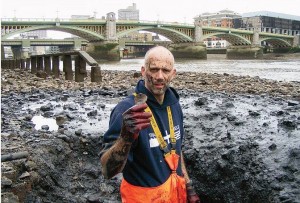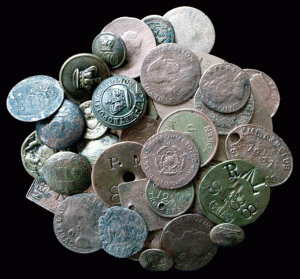 Reuters has a riveting profile of official Society of Thames Mudlark Steve Brooker. Mudlarks are an elite cadre of treasure hunters licensed by the Port of London Authority to search the muddy banks of the Thames in the old city for historical artifacts. Although anybody can scratch the surface of the low-tide shore, the most prime historical real estate — the north bank of the Thames between Westminster and the Tower of London which has hosted docking points for occupiers and traders since Roman days — is reserved for the licensed mudlarks.
Reuters has a riveting profile of official Society of Thames Mudlark Steve Brooker. Mudlarks are an elite cadre of treasure hunters licensed by the Port of London Authority to search the muddy banks of the Thames in the old city for historical artifacts. Although anybody can scratch the surface of the low-tide shore, the most prime historical real estate — the north bank of the Thames between Westminster and the Tower of London which has hosted docking points for occupiers and traders since Roman days — is reserved for the licensed mudlarks.
The Society of Thames Mudlarks was founded in 1980, but the name and profession go back to the late 18th century. Mudlarks back then were mainly children who scavenged the shore for anything of monetary value. Although they could find enough that was salable to not starve to death and at least they had some degree of independence, it was dangerous, filthy work. Untreated sewage, dead bodies, broken glass: when you’re barefoot and in rags, these are not fun things to have to wade through.
Today’s mudlarks have it comparatively easy. They are volunteers armed with a passion for history and comfy hip waders. They assiduously record everything they find. Any objects more than 300 years old go to the Museum of London to be logged. Most of their discoveries are returned to them after documentation, but particularly important finds are kept for research and display. For instance, one of Steve Brooker’s most compelling finds was a complete ball and chain, sans the leg it once shackled, that is now on display at the Museum of London Docklands.
Brooker is a window-fitter by trade. He is a self-taught expert in the history of London, and a highly valued one.
Kate Sumnall, an archaeologist and Finds Liaison Officer with the Museum of London who is charged with identifying mudlark finds says their work is “phenomenally important”.
“They have made a huge contribution by donating artefacts to us, but also in terms of the knowledge they bring because they have been showing us their finds for such a long time — I often learn from them,” she told Reuters.
“The medieval toys and pilgrim badges (they have found) are two of the key collections where their contributions have really helped change archaeological interpretation of the past.”
Sumnall estimates that the Museum of London gets 500 objects of historical significance a year from the mudlarks, including everything from medieval pottery to Viking decorative mounts to Roman leather shoes. Since the Thames was a garbage dump for as long as there have been people living on its banks, the mudlarks uncover these elements of everyday life from hundreds and thousands of years ago all the time. When they dig through the mud, they’re excavating an extended, intensely varied midden heap.
 So even though Britain’s Treasure Act applies to their finds — anything older than 300 years that contains more than 10% gold or silver belongs to the crown which will compensate the finder and landowner for its value — mudlarks aren’t really hunting for that kind of treasure. It’s items that have a clear connection to the past, like the low-value trading tokens that identify their former owners, that inspire excitement.
So even though Britain’s Treasure Act applies to their finds — anything older than 300 years that contains more than 10% gold or silver belongs to the crown which will compensate the finder and landowner for its value — mudlarks aren’t really hunting for that kind of treasure. It’s items that have a clear connection to the past, like the low-value trading tokens that identify their former owners, that inspire excitement.
Not that it’s all fun and games. It’s actually very hard, often dangerous work. The river has extreme tides, so those exposed muddy shores can find themselves filling up with high tide very quickly. Even the fully exposed mud can suck you down like quicksand if it’s thoroughly water saturated.
Brooker’s adventures larking about in the mud of the Thames are being televised. Mud Men airs on the UK History Channel and it sounds way too cool to end up on the US schedule. Brooker takes a radio personality with him on his digs, and visiting experts provide commentary on the finds and historical context. We get Ax Men instead. :blankstare:
Leg waders are an improvement obviously, but I would think that more would be needed to safely wade through the bodies.
There are far fewer to wade through these days, sad to say.
Sad to say? How many bodies floating in the river would you like?
I didn’t have a specific number in mind. Maybe a baker’s dozen?
I’ll see what can be done. :skull:
I’ve heard of mudlarks before, but never really knew what they were. This is totally awesome. Are there any good books on the activity? Also, if you hear more news about the show, please please please pass it on.
Henry Mahew wrote about the original mudlarks in his treatise London Labour and the London Poor in 1851. He describes a miserable existence, needless to say.
For the modern-day mudlarks, you might get a big kick out of Brooker’s websites (here’s one, here’s the other). They are both atrocious assaults to the eyeball, but there are thousands of pictures of artifacts found and digs on the Thames foreshore, enough to make navigating those poor hellish sites worthwhile.